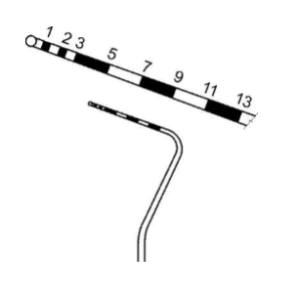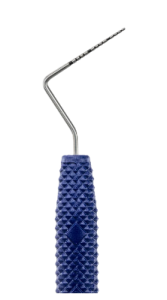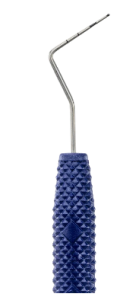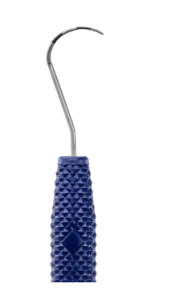Periodontal probing is an essential procedure in dental care, used to evaluate the health of your gums and the supporting structures of your teeth. This guide will help you understand what periodontal probing is, why it’s important, and what to expect during the procedure.
What is a Periodontal Probe?
To understand what periodontal probing is, one must first understand the periodontal probe. A periodontal probe is a dental instrument used to measure the depth of the spaces, known as sulci or pockets, between your teeth and gums. This measurement helps determine the health of your gums and whether you have any gum disease.
Key Features of a Periodontal Probe:

- Rod-shaped working end: This part of the probe is marked in millimeters to help measure gum pocket depths accurately.
- Smooth, rounded tip: Ensures that the probe can be inserted gently into the gum without causing damage.
- Millimeter markings: Different probes have different calibration patterns, but all are designed to provide precise measurements.
Types of Periodontal Probes:
Periodontal probes come in various designs, each with different calibration patterns. There are over 10 different types of probes, each with their own strengths and use cases. Here are a couple of common types:

UNC-15 Probe: This probe has measurements marked every millimetre, with darker markings at 5 mm intervals.

WHO (World Health Organization) Probe: Used for a quicker and less time-consuming periodontal screening procedure

Nabers Probe: Used for locating the area where the roots of your teeth split below the gumline, also known as the furcation.
Why is Periodontal Probing Important?
Periodontal probing serves several important purposes in maintaining and monitoring oral health:
- Determining Gum Health: By measuring pocket depths, dentists can assess whether your gums are healthy or inflamed. This is a sign that you are brushing and flossing using incorrect technique.
- Determination of Recession: Periodontal probing can be used to measure recession of the gums, another sign of gum health.
- Detection of Calculus: The probe can help detect the presence of hardened plaque, known as calculus, which needs to be removed to prevent gum disease.
What to Expect During Periodontal Probing
Technique and Procedure:
Gentle Insertion:

The dentist will hold the probe like a pen and gently insert it into the space between your tooth and gum, known as the gingival sulcus. The probe is kept parallel to the tooth to ensure accurate readings.
Walking Stroke:

The probe is moved in small increments around the entire tooth to see how deep the probe goes into the gingival sulcus. This can be read using the various markings on the probe’s outer surface. This method helps detect variations in pocket depth that may indicate gum disease.
Reading Measurements:

The dentist will measure from the junctional epithelium (the base of the sulcus) to the gingival margin (where the gum meets the tooth). This is done by feeling for the soft, resilient base of the sulcus.
Recording Results:

Measurements are taken at six points around each tooth and recorded on a periodontal chart.
Understanding Your Dental Probing Chart:

The periodontal chart records the measurements that your dentist will have collected from periodontal probing. It includes the following terms:
- Probing Depth: The depth of the pockets of your gums. Depths of 3 or less are a sign of healthy gums. Depths 4 or greater indicate progressively worse gum health, a sign of gingivitis or periodontitis.
- Free Gingival Margin: The amount of gum recession present on your teeth. Any gum recession is a sign of poor gum health.
- Bleeding: Bleeding, sometimes listed as bleeding on probing (BOP), is a measurement of whether or not your gums bleed when the periodontal probing commences. Bleeding indicates inflammation, a sign of poor gum health
- Furcation: The furcation is the area where the roots of your teeth split below the gumline. Usually, this is covered by bone. If a furcation is found, it is a sign of bone loss.
- Mobility: Mobility refers to the ability of your teeth to move when a dentist touches them. This is another sign of severe bone loss.
Based on the data that the dentist has collected, they may recommend a range of different procedures, including continuing to brush and floss and attending regular dental cleanings or, in severe cases, extractions, implants, and dental crowns.
Conclusion
Periodontal probing is a simple yet crucial procedure to maintain your oral health. By understanding what it involves and why it’s done, you can better appreciate its importance in detecting and preventing gum disease. Regular dental check-ups, including periodontal probing, are vital to keeping your gums and teeth healthy. If you have any concerns or questions about the procedure, don’t hesitate to ask your dentist for more information.
Disclaimer
The contents of this website, such as text, graphics, images, and other material are for informational purposes only and are not intended to be substituted for professional medical advice, diagnosis, or treatment. Nothing on this website constitutes the practice of medicine, law or any other regulated profession.
No two mouths are the same, and each oral situation is unique. As such, it isn’t possible to give comprehensive advice or diagnose oral conditions based on articles alone. The best way to ensure you’re getting the best dental care possible is to visit a dentist in person for an examination and consultation.
SAVE TIME AND MONEY AT ANY DENTIST

Less dental work is healthier for you. Learn what you can do to minimize the cost of dental procedures and avoid the dentist altogether!

